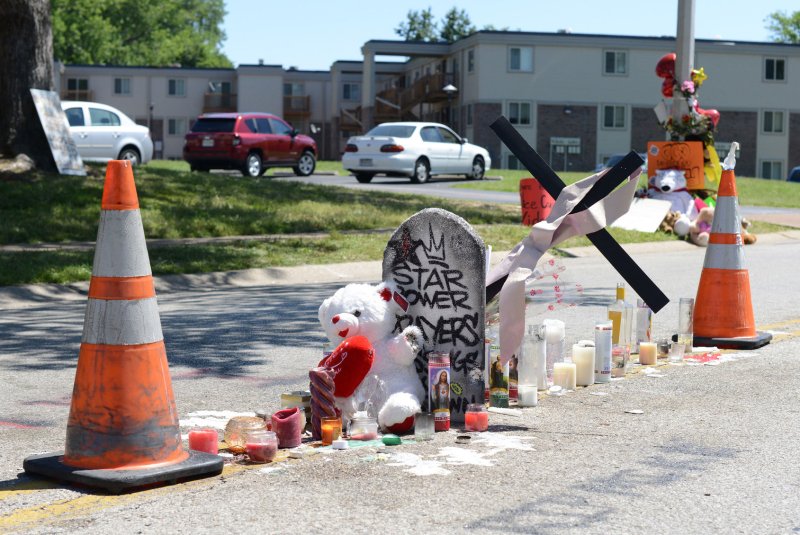1 of 2 | A makeship memorial has been established in the middle of the street in Ferguson, Missouri for the teen that was slain there by a Ferguson policeman on August 9, 2014. Michael Brown was shot numerous times after an apparent stuggle with the officer, setting off several days of protests and vandalism. UPI/David Broome |
License Photo
FERGUSON, Mo., Aug. 18 (UPI) -- Michael Brown was shot at least six times, including twice in the head, preliminary autopsy results released Sunday night revealed.
Brown, 18, was likely killed when one of the shots, likely the last to hit him, struck the top of his skull, indicating his head was bent forward at the time, the autopsy found.
He was also shot four times in the right arm, and all of the bullets were fired into his front, said Dr. Michael M. Baden, a former chief medical examiner for New York City, who flew to Missouri on the request of Brown's family to conduct the autopsy Sunday.
Baden, who detailed his findings in an interview with the New York Times, said the shots did not appear to have occurred at close range, because there was no gun residue on the body. But Baden said that determination could change if there was residue on Brown's clothes, which he was not able to examine.
"People have been asking: How many times was he shot? This information could have been released on Day 1," Baden said. "They don't do that, even as feelings built up among the citizenry that there was a cover-up. We are hoping to alleviate that."
Baden said three bullets were recovered from his body, but he was not given access to the X-rays showing where the bullets were found, nor to witness and police statements.
![]()
Part of a preliminary private autopsy report by Dr. Michael Baden and Professor Shawn Parcells showing wounds on Mr. Brown’s body. (New York Times/Michael Baden)
Brown's death at the hands of a police officer has touched off a week of protests in Ferguson, Mo., which only grew as local officials refused to release details of the official autopsy.
On Sunday, Attorney General Eric Holder ordered the Justice Department to conduct its own autopsy, citing the "extraordinary circumstances involved in this case."
The requests for additional examinations underlined the community's mistrust over local officials' ability or willingness to conduct a thorough investigation on their own, especially after Ferguson police waited six days to identify Officer Darren Wilson as Brown's shooter and released video of Brown allegedly committing a convenience store robbery they later admitted was unconnected to the shooting.
But Baden's findings are unlikely to give any clear-cut answers as to what happened in the final moments of Brown's life, during which witnesses said the teen had raised his hands and cried out for Wilson to stop shooting.
"This one here looks like his head was bent downward," Baden said, referring to the fatal shot to Brown's skull. "It can be because he's giving up, or because he's charging forward at the officer."
The exact details of the shooting remain under dispute: Witnesses from the scene have said Brown and Wilson struggled at the patrol car, and Brown appeared to be trying to get away. Police originally said the teen was reaching for the officer's gun, while witnesses said that did not appear to them to be the case.
Both sides agree police had yelled for Brown and Johnson to stop walking in the middle of the street before the struggle began.
Eyewitnesses said the officer chased Brown down the street, firing his weapon. Then, they said, Brown turned to face the officer with his hands over his head, and the officer fired again, and Brown fell to the ground.
"In my capacity as the forensic examiner for the New York State Police, I would say, 'You're not supposed to shoot so many times,'" Baden said, but acknowledged he did not have a complete picture. "Right now there is too little information to forensically reconstruct the shooting."
















